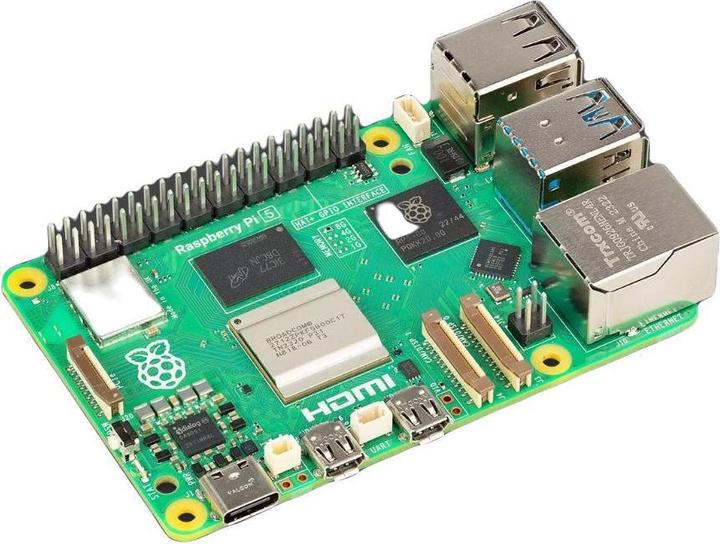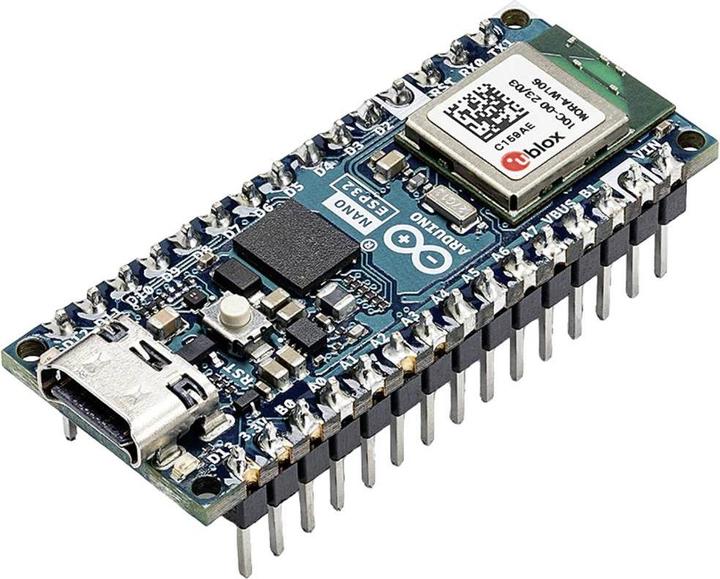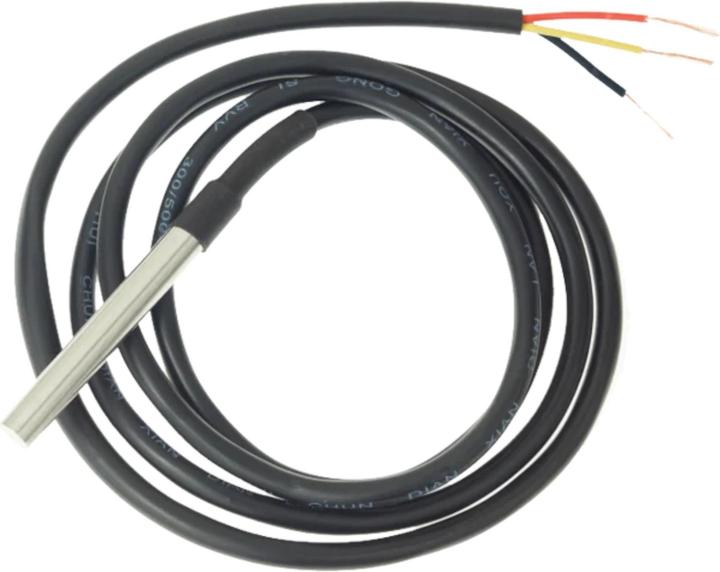
Best selling Development boards + Kits
Here's a ranking of the best products in this category. To give you a quick overview, we've also added some key information about the products.
1. Raspberry Pi New 5 / 8GB
The Raspberry Pi 5 8GB is a state-of-the-art development board that is perfect for a wide range of projects, from software development to building your own media centers. Equipped with a powerful Quad-Core Cortex-A76 processor and 8 GB of LPDDR4x SDRAM, this device offers outstanding performance and flexibility. The two microHDMI ports enable impressive video output, making it ideal for multimedia projects and dual-monitor setups. With two USB 3.0 and two USB 2.0 ports, the Raspberry Pi 5 provides extensive options for data transfer and connecting peripherals. Power is supplied via a modern USB-C port, ensuring a reliable energy source. Exceptional networking is facilitated by dual-band Wi-Fi, supporting both 2.4 GHz and 5 GHz, as well as Bluetooth 5.0/BLE for fast and stable connections. The Ethernet port allows for rapid data transfers at speeds of up to 1000 Mb/s, and the option to be powered via PoE (Power over Ethernet) offers additional flexibility.
Highlights:
- Built-in Quad-Core Cortex-A76 processor with a clock speed of 2.4 GHz
- Supports dual-band Wi-Fi (2.4 GHz and 5 GHz) and Bluetooth 5.0/BLE
- Two microHDMI ports for dual-monitor setups.

2. HutoPi Raspberry Pi 5 Starter Kit - 16GB Version
The Raspberry Pi 5 Starter Kit in the 16GB version from HutoPi offers a comprehensive solution for anyone looking to dive into the world of programming and electronics. This kit includes a Raspberry Pi 5 board with 16 GB of memory, powerful enough to realize a variety of projects. It also comes with a 27W USB-C power supply and an official Micro-HDMI to HDMI cable (1 meter) to ensure easy connection to monitors or TVs. The official case protects the board while providing an attractive appearance. Additionally, a 64 GB Noobs micro-SD card is included in the kit, allowing for user-friendly installation of the operating system. This starter kit is ideal for learners, hobbyists, and developers looking to expand their skills in computer technology. With the Raspberry Pi 5, you can implement a wide range of applications and projects, from programming to multimedia applications.

3. HutoPi Raspberry Pi 5 Starter Kit - 8GB version
The Raspberry Pi 5 Starter Kit - 8GB Version is a comprehensive set that provides everything needed to get started in the world of Raspberry Pi development. It includes the powerful Raspberry Pi 5 board featuring a Broadcom BCM2712 SOC, which encompasses a 2.4 GHz 64-bit Arm Cortex-A76 quad-core CPU and 8 GB of DDR4 RAM. The kit is ideal for developers and tech enthusiasts looking to take advantage of the new features and revamped connection layout of the Raspberry Pi 5. With dual-band 802.11ac Wi-Fi, Bluetooth 5.0, and two 4Kp60 HEVC-capable micro-HDMI ports, this kit offers versatile connectivity options and impressive performance.
Highlights:
- Includes a 32 GB micro-SD card with pre-installed operating system
- Official 27W USB-C power supply and case with integrated fan
- Standard 40-pin Raspberry Pi GPIO interface.

4. Raspberry Pi 4 4GB Model B
The Raspberry Pi 4 Model B is the latest computer board from Raspberry Pi. This version offers more processing power, more memory, and more connectivity while remaining backward compatible with projects created on earlier models. What is a Raspberry Pi? A Raspberry Pi is a compact computer board that offers endless possibilities. From the very beginning, the Raspberry Pi was designed to be easy to use and customizable. Simply connect a TV or monitor, a keyboard, a mouse, and a power supply, and you can get started. A Raspberry Pi is great because the device is suitable for almost all age groups. Whether you want to teach children programming or engineers want to create complex computer-controlled systems, anyone can use a Raspberry Pi. There is a wide range of "HATs" (Hardware Attached on Top) and other accessories that you can connect to the Raspberry Pi to utilize special features.

5. Arduino Starter Kit German
With the Arduino Starter Kit, you can quickly and easily start learning about electronics. It appeals to STEAM enthusiasts at home, businesses in the STEAM industry, and schools alike. No prior knowledge is required, as the kits introduce both coding and electronics through fun, engaging, and hands-on projects. With the starter kit, you can teach students about electricity, voltage, and digital logic, as well as the basics of programming. There is an introduction to sensors and actuators and how to understand both digital and analog signals. Throughout all of this, you teach students how to think critically, learn collaboratively, and solve problems.

6. Arduino ABX00083 Board Nano ESP32 with headers Nano
The Nano ESP32 is a powerful addition to the Arduino ecosystem, bringing the popular ESP32-S3 into the world of Arduino and MicroPython programming. Whether you are a beginner venturing into the realm of IoT or MicroPython, or an advanced user looking to integrate it into your next product, the Nano ESP32 is the perfect choice. It covers all your needs to kickstart your IoT or MicroPython project with ease.
Let’s take a look at the main features of the Nano ESP32:
- Tiny footprint: Designed with the well-known Nano form factor in mind, this board is perfect for embedding in standalone projects due to its compact size.
- Wi-Fi and Bluetooth: Harness the power of the ESP32-S3 microcontroller, renowned in the IoT space, with full Arduino support for wireless and Bluetooth connectivity.
- Arduino and MicroPython support: Seamlessly switch between Arduino and MicroPython programming with just a few simple steps. We even offer an introductory course for those new to the world of MicroPython. More information can be found on the documentation page.
- Arduino IoT Cloud compatible: Quickly and easily create IoT projects with just a few lines of code. Our setup takes care of security and allows you to monitor and control your project from anywhere using the Arduino IoT Cloud app.
- HID support: Emulate human interface devices, such as keyboards or mice, over USB, opening up new possibilities for interaction with your computer.
There are no more excuses to postpone your exploration of IoT and MicroPython. The Nano ESP32 provides everything you need to start developing and discover endless possibilities.
Technical specifications
- Board Name Arduino Nano...

7. Arduino UNO R4 WiFi
The Arduino UNO R4 boards feature a powerful 32-bit microcontroller that offers more processing power and memory while maintaining the standard UNO form factor and 5V operating voltage. They are an excellent option for both beginners and experienced electronics enthusiasts looking to push the boundaries of their projects. While retaining the familiar features of the UNO family, the UNO R4 boards provide a 32-bit architecture and exciting new capabilities for makers.
The Arduino UNO R4 boards are equipped with a powerful 32-bit microcontroller from Renesas, which offers increased processing power, memory, and on-board peripherals. Importantly, these enhancements do not compromise compatibility with existing shields and accessories, nor do they require changes to the standard form factor or the 5V operating voltage. With its robust design and reliable performance, the UNO R4 is a valuable addition to the Arduino ecosystem. It is suitable for both beginners and experienced electronics enthusiasts who want to expand the limits of their projects.
The UNO R4 has the same pin layout and 5V operating voltage as its predecessor, the Arduino UNO R3. This means that existing shields and projects can be easily ported to the new board. The UNO R4 features several exciting new peripherals, including a 12-bit DAC, CAN BUS, OP AMP, and SWD port. These additions broaden the possibilities for developers and enable more advanced projects.
With more memory (16x) and a faster clock speed (3x), the UNO R4 can perform more precise calculations and handle more complex projects. This allows developers to create even more demanding and sophisticated projects.

8. HutoPi Raspberry Pi 4 8GB Starter Kit
The HutoPi Raspberry Pi 4 8GB Starter Kit is a comprehensive solution for developers and tech enthusiasts looking to realize powerful projects. This kit includes everything needed to get started right away. The Raspberry Pi 4 is equipped with a Quad-Core Cortex-A72 processor that reaches a clock speed of 1.5 GHz and features 8 GB of LPDDR4 RAM. This enables efficient processing and multitasking capabilities. The kit includes a 32 GB Micro SD card with the pre-installed NOOBS operating system, making it easy to get started. Additionally, it comes with a case, a USB-C power supply, and a Micro-HDMI to HDMI cable for easy connection to monitors. The integrated heat sinks ensure optimal temperature regulation, while the versatile connectivity options, including Gigabit Ethernet and Wi-Fi, allow for flexible use. This starter kit is ideal for anyone looking to dive into the world of programming and hardware development.
- Quad-Core Cortex-A72 processor with a 1.5 GHz clock speed
- 8 GB LPDDR4-3200 SDRAM for enhanced performance
- Includes a 32 GB Micro SD card with pre-installed NOOBS operating system
- Versatile connectivity options: Gigabit Ethernet, Wi-Fi, and Bluetooth 5.0
- Heat sink package for temperature regulation and stability.

9. Shelly Temperature sensor DS18B20 (1 metre)
If you want to connect more than one DS18B20 temperature sensor to your Shelly addon, you can use this sensor (a maximum of 3 can be connected).
Technical details:
Cable length: 1 m
Sensor type: DS18B20
Accuracy (-10 °C - +85 °C): ±0.5 °C
Max. permissible temperature of the probe: 100 °C
Probe diameter: 6 mm
Connection cable: VCC (red), GND (black), Data (yellow)
Weight: 20 g
Delivery includes:
1x 1 m Shelly temperature sensor DS18B20.

Shelly Temperature sensor DS18B20 (1 metre)
10. Arduino Mega 2560 Rev. 3
The Arduino Mega 2560 is a microcontroller board based on the ATmega2560 with a clock speed of 16 MHz. It features 54 digital input and output pins, 16 analog inputs, four serial interfaces, and a USB connection. The necessary components for programming and operating the microcontroller are included on the board. Simply connect the board to your PC and develop exciting applications. Power can be supplied via USB, an external power supply, or batteries. Arduino is an open-source physical computing platform that is based on easy-to-use hardware and software. The goal of this platform is to enable artists, designers, hobbyists, and other enthusiasts to create interactive objects. Sensors and microcontrollers are used to make analog inputs available to software applications and/or to control electromechanical devices such as motors, servos, LEDs, or other hardware.


